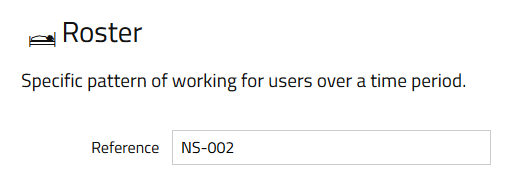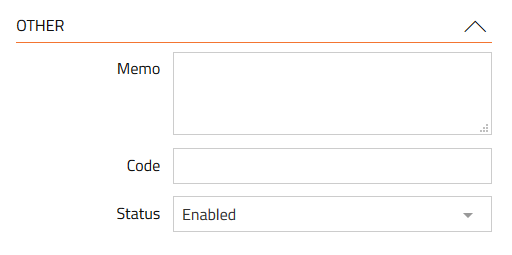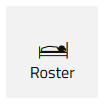Rosters
A detailed look at the fields and dependencies in the Rosters records, how to create a new Roster record & editing existing Rosters.
Rosters are only available in the Standard
and Enterprise
versions of Solarvista. If you are using Lite
, please skip to Teams or return to Setting Up Data.
The “Rosters” record holds information about specific User’s working time pattern (and therefore by definition the non-working time). For example, most Users could have a “Standard Working Week” of Monday to Friday, 0900 to 1730. Rosters can be applied to multiple Users at once, or groups of Users defined by Teams.
A Roster must contain a single Shift Pattern and at least one User. Rosters also mandate single Time Zone to operate to. Multiple Rosters are needed if you work across different time zones. All other fields are optional. If you add a Team, all the Users of the selected Team will have their working time updated accordingly.
If you add dates in the Validity section, the roster will be applied between the dates only. If Valid From is populated only, the roster will be applied from the date, in perpetuity. If Valid Until is populated, it will apply the roster from current date to the date entered.
Where Roster Records are Used
The following files refer to Roster records so if you plan to use any of these, setting up the records in this file will be important or even critical:
None.
Pre-requisite Files for Roster Records
When setting up Roster records, it is recommended to review the other data files that may need to be referred to by each record. These are the files that you may need to setup in advance:
Data Sources
- Shift Patterns
- Teams
System
- Users
Field Descriptions for Roster Records
The ID section holds the unique ID for the record:

Reference - holds the unique ID for the record (most records in Solarvista have one of these). It cannot contain any spaces or non-standard characters. Once the record is saved, it is not possible to edit it afterwards. In most default situations, the Reference is automatically set using a counter sequence, however, you can setup your own if you prefer.
The Details section holds the detail of the roster:

Name – the name of the Roster e.g. “Standard, Q1”, “Weekends, Q2”, “Shift Style 2, Week 14”.
Shift Pattern – the selected Shift Pattern that should be applied during the roster entry.
Time Zone – the Time Zone that the roster should use. This allows different Rosters for different time zones to be handled whilst using the same Shift Patterns.
The People section holds the detail of the users to apply the roster to:

Users – a list of Users who should have this Roster applied.
Teams – a list of Teams who should have this Roster applied.
The Validity section holds optional dates for validity of the Service Level:

Valid From – the date from which the Roster should be valid. If not populated, the validity is assumed, subject to the Valid Until field.
Valid Until – the date until which the Roster should be valid. If not populated, the validity is assumed, subject to the Valid From field.
The Other section holds miscellaneous additional information:

Memo – a free text field that can be used for any purpose.
Code – used to hold an optional alternative ID code. This may be applicable in situations where information is being transferred to other systems via Connectors and the code here is used to identify the record to the other system.
Status – defines the status of the record as follows:
- Disabled – is not active. The record will not appear for selection in other parts of the system.
- Enabled – is active. The record will appear for selection in other parts of the system.
Creating a New Roster Record
To create a new Roster record:
- Click on the “Plus” button.

A menu will appear. - Within the “Data Sources” section, find “Roster”.

- Click on “Roster”.
- A new “empty” Roster record will appear.
- Populate all fields as you require.
- Click on the “Create” button.

- You may need to refresh the page to see the new record in a view.

Editing a Roster Record
To edit a Roster record:
- From the main menu, select Rosters.

The default view for Rosters will open. - Click on the Quick Filter button.

- Enter criteria for the Roster record you are looking for and click Apply button.

- The view will update. Find the record you are wanting to edit.
- Click anywhere on the row that shows the record. The record will open.
- You can edit any field that allows editing (some could be set to read only).
- Click on “Save” button to save changes.

Deleting a Roster Record
To delete a Roster record.
- From the main menu, select Rosters. The default view for Rosters will open.
- Click on the Quick Filter button.

- Enter criteria for the Roster record you are looking for and click Apply button.

- The view will update. Find the record you are wanting to delete.
- On the left side of the view is a column containing checkboxes.
- Check the box of the record you want to delete.
- Click the “Delete” button on the top right.

A slide in dialog will appear prompting you to confirm the delete, by typing in the word “DELETE” again. - To confirm, click the “Delete” button and the record (or records will be deleted).

Note: You can delete Roster records referred to only by other Data Sources however this will leave those records without an associated to a valid Roster record. If this happens by accident, you can manually recreate the record ensuring the Reference is identical. You can also change the status of the record to prevent it appearing on screen in future whilst maintaining historical integrity.
Customising or Adding New Fields
Solarvista™ is built upon a uniquely flexible platform that allows you to edit fields (or remove them in some cases) as well as add your own fields. These new fields (or edited characteristics of existing fields) automatically become available within the web portal and the mobile apps. For more information, refer to the Customising section.
Importing Cause Data in Bulk using Import Tool
If you have a lot of Cause information to enter, you may prefer to upload this using the Import Tool that’s built into Solarvista. The Import Tool enables Cause records to be created from “CSV” text files. CSV files can be created from a wide range of popular applications including Microsoft Excel. For more information on importing data into Solarvista, please refer to the article here.